Well the problem with VirtualDub and TMPGEnc is that they work in the RGB colorspace.Originally Posted by GreyDeath
DVD video and video captures are in YUV/YUY2 colorspace.
AviSynth and CCE use YUV/YUY2 colorspace.
This can make a big difference.
So that is why I use AviSynth and CCE
It just "makes sense"
VirutalDub fitlers and TMPGEnc is hand holding. It's what you learn when starting out. Then you graduate to AviSynth and CCE.
It is the natural order of things
- John "FulciLives" Coleman
+ Reply to Thread
Results 61 to 83 of 83
-
"The eyes are the first thing that you have to destroy ... because they have seen too many bad things" - Lucio Fulci
EXPLORE THE FILMS OF LUCIO FULCI - THE MAESTRO OF GORE
-
No ******* way cce with avisynth is the graduation of this hobby. Neither the "natural order of things".
This is a gum the cce / avisynth fans try to sell to the scene.
I base that in the fact that most CCE / Avisynth users simply use ready scripts from others. And plenty avisynth users, don't even know what they doing. They following "suggestion" from the "experts".
But the average Virtualdub user, spent hours setting up filter chains! This is graduation IMHO. I can see a pic and suggest filters as the average virtualdub user. The average avisynth user can't do that. Only the very few true avisynth experts can somehow do it. Those few that actually made scripts and combine filters, not the plenty others that simply use what they found ready on the net from others and use them without really know what they do...
For the story, Avisynth, started for one reason basicly : To automate some virtualdub operations, fix the colourspace and boost the speed.
But after a while, it end up a tool to non GUI application supporters, simply porting to scripts virtualdub solutions.
The bottom line is that the top application of this hobby is Virtualdub. Avisynth can't replace it at any way.
And yes, the colourspace convertion (YUV2>RGB>YUV2) is a visible problem mostly with the NTSC (Never The Same Colour) VHS projects. Not a huge issue for us in PAL land, but for the NTSC it might be problem, under specific variables. -
Well SatStorm I don't know what to say. I like you so I really don't want to get into a fight here but some of the things you said are a bit "off".
What's wrong with using someone else's script or a part of it that does something you need? I don't see a difference between that and VirtualDub filters. You don't "see" the programming behind the filter. All you need to know is that it works. Odd reasoning on your part.
Also the colorspace conversion is an issue even for PAL people. Yes USA NTSC has a 7.5 IRE black level whereas PAL and Japanese NTSC have a 0.0 IRE black level but all DVD discs ... NTSC and PAL ... are in YUV/YUY2 format. Converting to RGB is not the greatest thing to do.
Plus AviSynth and CCE is faster than VirtualDub and TMPGEnc. Even AviSynth and TMPGEnc is faster than VirtualDub. VirtualDub is a REALLY slow frameserver.
Yes I value quality above speed but the speed is the icing on the cake.
- John "FulciLives" Coleman"The eyes are the first thing that you have to destroy ... because they have seen too many bad things" - Lucio Fulci
EXPLORE THE FILMS OF LUCIO FULCI - THE MAESTRO OF GORE
-
I say just use whatever works for you and that you're comfortable with. "Let's not bicker over who killed who..."

All in all, I've given up on getting the "Perfect" picture. Rendering and Rerendering the Star Wars trilogy for 6 months taught me that. As of now, I have found an acceptable middle for rendering TV eps and my old VHS tapes. A little more graininess for the most part won't upset me since most of the stuff I put to DVD I watch on a TV and not the computer. Of course, that may change once I get a 60" HD Widescreen.
And your friends who watch your encodes most likely won't notice the little faults. And if they do... tell them to make their own DVD's! "*sigh* Warned you, we tried. Listen, you did not. Now SCREWED, we all will be!" ~Yoda
"*sigh* Warned you, we tried. Listen, you did not. Now SCREWED, we all will be!" ~Yoda -
I capture off cable TV also but from the composite video out on the cable box. This goes directly to composite video inputs on a Pinnacle DC10+. The quality is as good as the samples in this thread since I am capturing using low loss MJPEG format. Also given my OTA reception, this is the best picture quality I can get from broadcast TVOriginally Posted by tonsofpcs
-
Here are my VHS captures from my hauappage wintv-250 using S-Video inputs. These captures are from a tape back in 1988!!
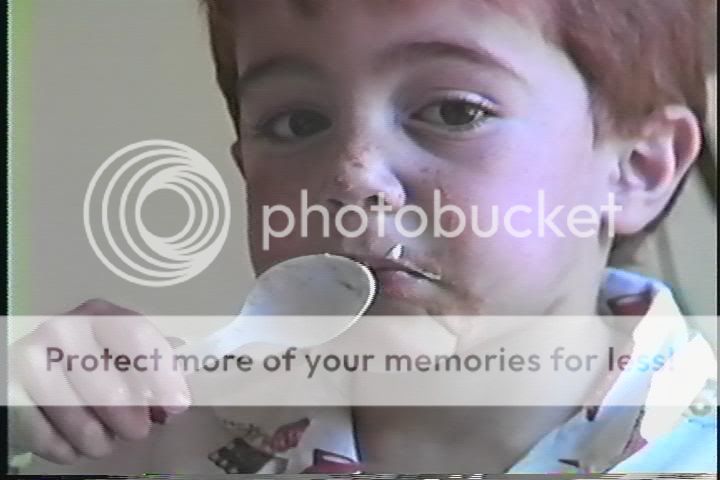
Thats me
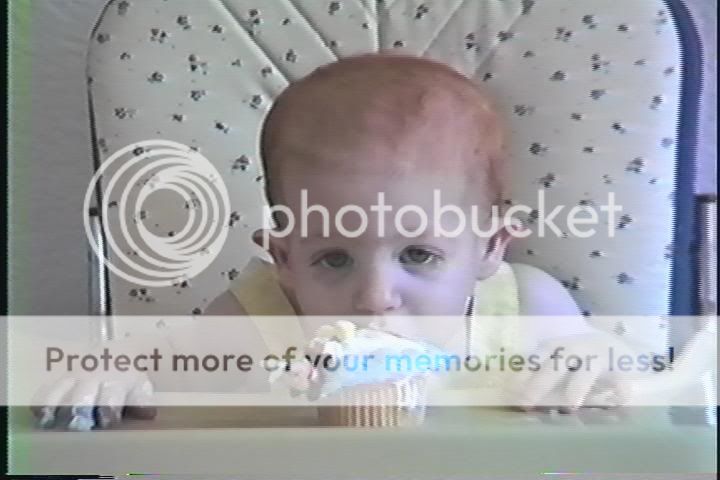

CAKE!!

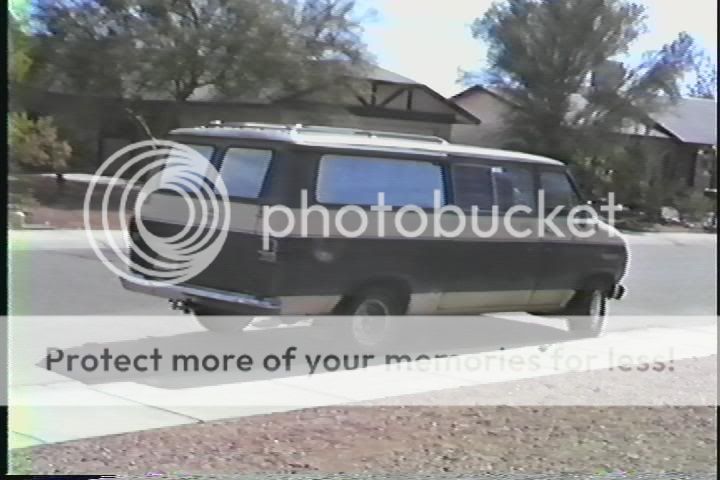
Pretty old van! LMAO! -
No, I haven't tried those. I'm thrilled with the Dazzle 150 because it captures video tapes that my ATI AIW Radeon 7500 would not. The quality looks great to me but I'm not dealing with high quality source material and watching it on big screen TV like the some of the videophiles around here. It's possible that some other device might have a better "upper limit" of quality, I don't know anything about that.Presto, have you tried Canopus ADVC100 or Pyro AVS or are you just assuming that Dazzle is good enough? From other posts on this site it seems that Dazzle has gotten less positive feedback than the other two I mentioned.
The only hitch I see in the Dazzle 150 is Studio 8. Nothing has changed in over two years that I've been using it on and off. The forums and reviews here are still a mixed bag. Everyone agrees it is a great interface and powerful editor. It's just that some people have so many crashes and corrupt projects that they can't get anything done. Others seem to have no problems. Are the people with no problems doing less ambitious projects or are they using S8 to edit and then authoring with something else? Or are they just lucky?
I still think recommend it. If you are lucky there will be no problems. At worse you will find that you can do all your editing in S8 and output to another program to author. No big deal really. -
[quote="presto"]
From my perspective there is no such thing as beeing "lucky" in computer world. Certain behaviour is triggered by certain things, they just don't happen on their own. Good troubleshooting skills, maintenence and stable OS (with registry not bloated by junk) is all it takes. You have to learn these skills. After that you have a high probability of beeing lucky most of the time.....Or are they just lucky? -
Yeah I love picture pages

Here are two screenshots from a VHS SP tape recorded from HBO of the movie NIGHT OF THE COMET
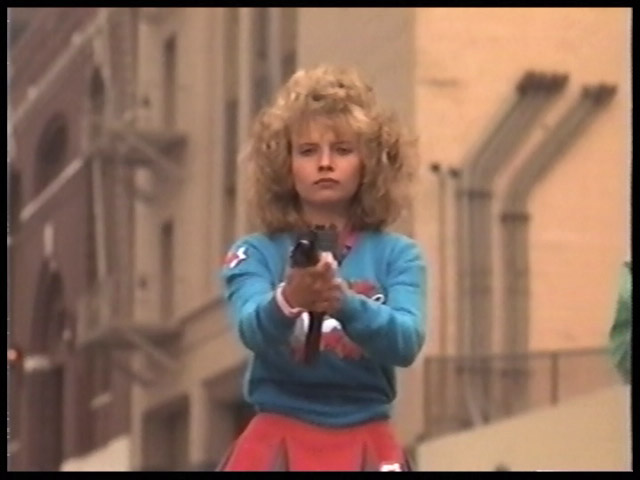
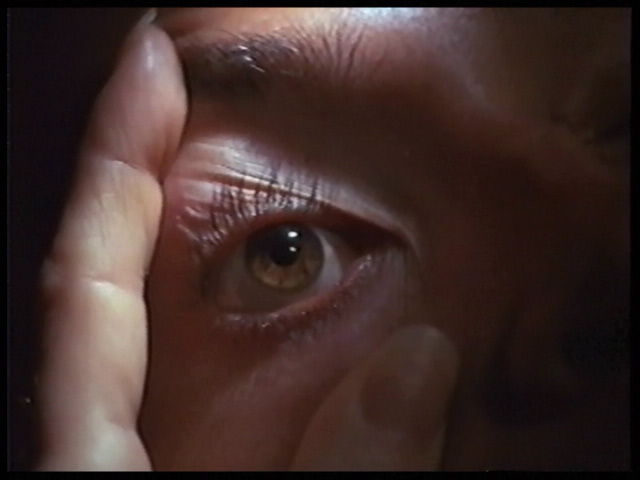
CAPTURE INFO:
Capture using PCI BT based capture card (AverTV Stereo) with BTwincap drivers. Full D1 resolution capture with PICVideo MJPEG on 19 quality setting. Processed with AviSynth using Convolution3D noise filter and encoded in CCE at a CBR of 8000kbps using Full D1 resolution (NTSC)
MPEG file played back and captured through WinDVD
- John "FulciLives" Coleman
*** EDIT ***
Changed the 2nd picture to a scene that takes place later in the movie. Again this sample clip was captured and filtered and encoded the same way. I felt the original 2nd pic was too close to the 1st hence the change."The eyes are the first thing that you have to destroy ... because they have seen too many bad things" - Lucio Fulci
EXPLORE THE FILMS OF LUCIO FULCI - THE MAESTRO OF GORE
-
I've had this little discussion dozens of times. Do you really think there is no luck? A good driver is less likely to get into an accident than a bad driver but sometimes people just have sink hole open in front of them (sink holes are holes that develop here in Florida and cause the highway to suddenly open up and swallow cars, unlucky cars).From my perspective there is no such thing as beeing "lucky" in computer world. Certain behaviour is triggered by certain things, they just don't happen on their own. Good troubleshooting skills, maintenence and stable OS (with registry not bloated by junk) is all it takes. You have to learn these skills. After that you have a high probability of beeing lucky most of the time.
When I spoke of luck above I was obviously talking about the spin of the roulette wheel that is how your system (even a brand new one) and Studio 8 interact.
Proxy99 some people hook up Studio 8 and go to town and have almost no problems. Other people even quite knowledgable people who keep a clean machine have all sorts of trouble. No two computer set ups are alike and Studio 8 is not a robust program (I don't know that that term is correct but I have come to use it to distinguish between programs that seem to work on just about any set up and programs that don't)
Yes, with Studio 8 some people are luckier than others. The fact that experienced users can handle problems better than unexperienced users is obvious. -
Just to clearify:
I don't doubt avisynth's use and the pros it has, neither I said that something is wrong using ready scripts.
I doubt that avisynht is the graduation of this hobby! When someone say this, just piss me off... (yeah, I have a bad temper, that's true...)
Expecially when most of the users simply use ready scripts. At least, virtualdub users set the filters by themselfs! They know what they are doing and see it all the time in frond of their eyes. They judge the results and they decide what to use. On the other hand, most avisynth users simply follow rules and suggestions from experts. They apply scripts, convert to mpeg 2 and never doubt the results, because the "experts said so". This is not graduation, neither knowledge of the subjects.
I do plenty of test all the time and I doubt many "popular" scripts floating in the net. I can succeed much better results by myself, using virtualdub (and sometimes export a script to use it with avisynth, but that way I use avisynth as a tool to succeed specific results fast)
IMHO, programing a script is not the graduation of this hobby. See a source and add the correct filters so the enchance the results is! Only when you can do this by yourself, you have graduate. Using ready scripts means nothing. You get my point?
And about DVDs and colourspace, that's a different thing. The question here is not about DVD to DVD but VHS to DVD.
So the colourspace issue from VHS source converted to DVD is more of a theory issue. If you have a so good equipment and capture cards (all the 8bit cards of the market are uncapable for this) to use, you might see something with the colours. But if you are able to see a difference with bt8xx based cards, VHS captures and convertions to mpeg 2 using avisynth / cce because of the colourspace, then you are a very lucky person! You must have a high end screen with dvi input, the perfect DVD standalone with DVi output and 20/20 vision !
I don't think that I'm off, I believe that this side of the story, only rarelly mention on the boards.... -
Did you resize the screen captures? They look vga (640x480) resolution instead of D1.Originally Posted by FulciLives
-
Can you back the filters down a bit? They look a bit too soft. Very nice otherwise

-
OK you shamed me into giving VirtualDub another try. And I think I did it.Originally Posted by SatStorm
I know the filters and settings are subjective and change for different situations. But for my first test I used your recommendation for the above video. My test was not for particular results but to learn the process.
I used a 5 minute DV video, downloaded and selected the above filters and settings in VirtualDub, and framed served to TMPEGEnc. Selected the framed served file and encoded using my normal TMPEGEnc settings (no filters, except for clip frame for cropping) I use full D1, with 2 pass VBR, 6900 avg and 8000 max bitrate, motion estimate search. I working with old camcorder VHS tapes.
I believe it worked. It did not give me better results, but at least I know I can do it.
My question is regarding the added time it took. My TMPEGEnc settings without the VirtualDub is about 3.5 X real time, with the frame serve it was 6.6. That is almost double.
I could live with that, if I can ever find a combination of filters and settings that improves my video.
But is there something I might be missing that would speed up the process to somewhere closer to the numbers you had indicated? -
I think I have to clearify and about the suggestion of using filters:
Each source needs different kind of filtering! For example, the chain I suggest you, was only for the VHS capture of that music video you post. It has no use with a home movie DV source!
For DV source, you need other kind of filters, different chains and almost a different approach!!!
What I mean:
With DV sources, we basicly filter not for the things we see, but for the things we don't see but the encoder do see! The theory behind "filtering" DV sources (and home movies in general), is to eliminate / smooth background unoticable noise so any encoder spread the bitrate better during the frames!
From a perfect VHS or DV source, you can capture and transfer direct to DVD (encode) using high bitrates (about 1 hour per Disc that way). The result gonna be indentical with your source that way.
But if you minnor filter the same source, you can succeed identical the source VISUAL results, in a smaller filesize.
This is the "secret" when you convert VHS tapes for example: You filter some minnor things and you end up capable to transfer 4 Hours on 1 DVD-R visually perfect.
With the DV sources, you only minnor filter just to make it possible to convert 2 Hours per DVD-R, without visual quality loss
Anyway: If you wish to test the filters I suggest you, just try to do it with your music video from your VHS tape! For your DVs you won't notice any visual difference.
And about the time: Virtualdub frameserve's slow and that was one of the reasons avisynth appeared! To speed up this proccess, fix bugs and support advance needs of advance hobbiests!
Why virtualdub is slow? Here comes the colourspace problems: It has to convert anything to RGB, proccess it, convert it again to YUV and frameserve it to TMPGenc. There, TMPGenc again gonna convert it to RGB to import it and again convert it to YUV so to encode it.
This is the problem with virtualdub and TMPGenc unfortunatelly... avisynth / cce gain much of the speed because of those not neccessary convertions of the colourspace. And the problem is that no alterantives exist for this when you use virtualdub / TMPGenc.
There is one way to frameserve direct YUV with Virtualdub (fast recompress method) but that way, you can import filterts. BUT, you can resize! And resizing outside TMPGenc also boost the final result.. -
In this context, which applies to VHS transferred with an ADVC - 100, since my original source is VHS but I'm bringing it in as DV AVI.Originally Posted by SatStorm
And does the DV codec make a difference in the filter/encoding process?
I use WinDv type 2, which is Panasonic codec. I have read about some type of color differences in DV codecs (MainConcept and Canopus). -
if you use passthrough bridge from a DV cam, you have better results concerning the cables, the ability of the capture card and other things.
Here is a fast example about the filters
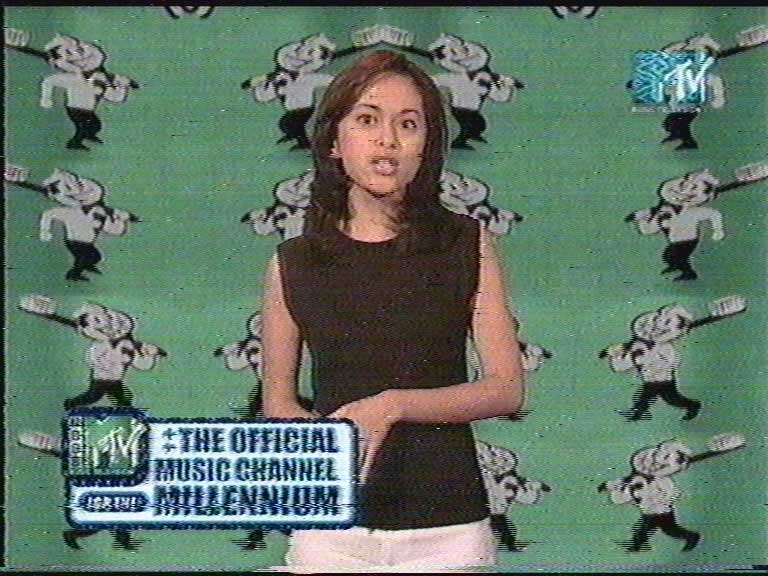

This is through composite, a cheap VCR and a bt8xx based card
The worst you can get!
The tape is LP PAL, from summer 1996. The channel is MTV Asia, I use to receive it analogue through band C from Panamsat 68.5 East
What you can't see in this example, is how smooth and how clean the motion and the overall picture is using filters.
Filtering is about correcting bad tapes. You can't enchance already commercial VHS movies that mach. But you can do miracles with sources like that.
This is the missunderstanding about filtering! -
And here is a direct frame from a PAL DVB channel. Looks like shit, isn't it?

So you realise that even with the so called "clean" DVB transmissions, filtering is neccessary! -
Those captures done through WinDVD which resizes them to 640x480 for a proper 4:3 aspect ratio.Originally Posted by Manokat
- John "FulciLives" Coleman
P.S.
I used the Convolution3D setting called vhsBQ which CAN be a bit "too much" sometimes in terms of detail loss but often the next lower setting is not enough so what can you do hehehe"The eyes are the first thing that you have to destroy ... because they have seen too many bad things" - Lucio Fulci
EXPLORE THE FILMS OF LUCIO FULCI - THE MAESTRO OF GORE
-
I know you guys love using composite cables, so here are some more captures:
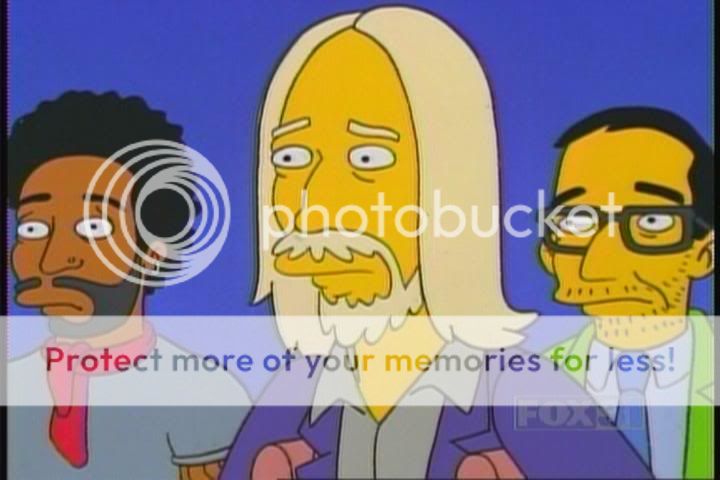
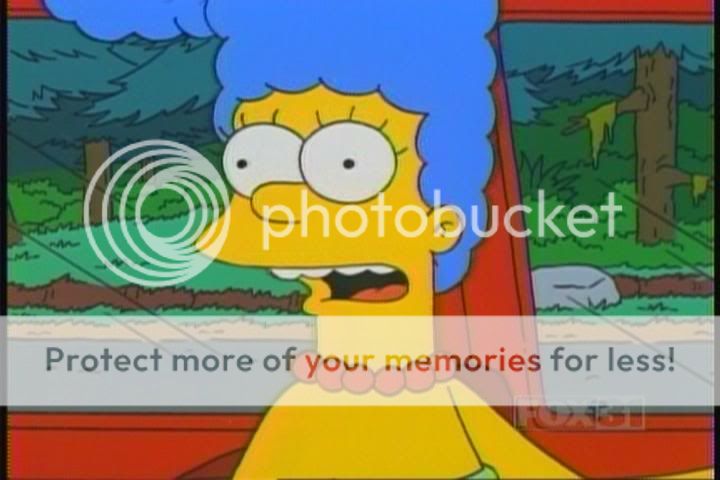
-
@Manokat:
How do you like your Plextor captures? Do you have any problems with the device? -
When they first released the driver back in february, it did have a problem with video having blue, purple and green noise. Then they released two updates for the driver and they update the software.Originally Posted by Phantom Of The Opera
Now it does not have any problem, IMO.
Similar Threads
-
Slightly OT: Roxio announces VHS capture Device Solution
By terryj in forum MacReplies: 5Last Post: 1st May 2012, 00:19 -
Best VHS capture device
By underworldmagic in forum Capturing and VCRReplies: 27Last Post: 2nd Jan 2012, 06:09 -
Best outboard consumer capture device today? VHS, LD, camcorder and HD DVR
By cosmichippo in forum Capturing and VCRReplies: 4Last Post: 11th May 2010, 14:46 -
What device to use for VHS capture ?
By dazz700 in forum Capturing and VCRReplies: 3Last Post: 17th Mar 2009, 16:18 -
Capture device needed for old VHS or 8mm camcorder capture....What to get?
By thor911 in forum Capturing and VCRReplies: 11Last Post: 5th Oct 2007, 05:31




 Quote
Quote